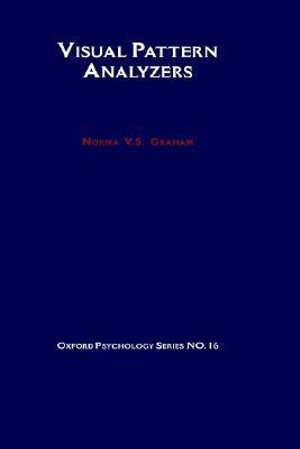The visual system must extract from the light that falls on the retina meaningful information about what is where in our environment. At an early stage it analyzes the incoming sensory data along many dimensions of pattern vision, e.g. spatial frequency, orientation, velocity, eye-of-origin. Visual Pattern Analyzers provides a definitive account of current knowledge about this stage of visual processing. Nowhere else can such a comprehensive summarty of the lower level pattern analyzers be found. The book's emphasis is on psychophysical experiments measuring the detection and identification of near-threshold patterns -- and the mathematical models, such as multidimensional signal-detection theory, used to draw inferences from such experimental results -- but neurophysiological evidence is presented and compared critically to the psychophysical evidence. Introductory material on psychophysical methods, signal detection theory, and the mathematics of Fourier analysis is given in
order to make the book more accessible to all who are interested in the lower or higher levels of visual perception. This volume will be of great value to researchers and graduate students in the fields of vision and perception. Within the scientific community there is wide interest in the visual system, and the book will be of use to investigators in many fields, including psychophysics, neuroscience, ophthalmology and optics, computer science, and cognitive and experimental psychology.
Industry Reviews
"The author, a respected scholar in this field, has done an excellent job of organizing and summarizing a massive amount of data. This reviewer knows of no other work that has attempted such an exhaustive compilation of the studies in this field . . . .A clearly written and helpfully illustrated, but highly technical work." --Choice
"The author, a respected scholar in this field, has done an excellent job of organizing and summarizing a massive amount of data. This reviewer knows of no other work that has attempted such an exhaustive compilation of the studies in this field . . . .A clearly written and helpfully illustrated, but highly technical work." --Choice
"The technical focus on visual perception is excellently grounded; treatment is thorough and thoughtfully presented . . A volume in which content moves from adaptation to summation, covers uncertainty and identification, even when multiple dimensions are involved . . . . The publishers complement the work with fine printing and a superb binding." --Perceptual and Motor Skills
"Graham's book will no doubt become a classic. . . .The book's intricate structure and meticulous organization, so impressive to those familiar with the material from other sources, gives it a distinct personality. . . .Grandly exhaustive, labor-intensive. . .it deserves recognition as a classic." --Contemporary Psychology
"I found it immensely rewarding. . . .An essential book for established and budding gratingologists and, indeed, for anyone interested in early visual processes. Graham has provided not only a coherent and detailed account of the main thrust of visual psychophysics over the past twenty years, but also a broader framework into which to fit less developed psychophysical work." --Perception
"A successful attempt to develop a formal, systematic structure around the considerable literature that has accumulated over the past 25 years. . . .The book is nothing if not thorough. . . .The presentation is clear, and the organization is excellent. . . .Graham's book will prove to be of great value as a source of information. . . .Because of its thoroughness and emphasis on methods and assumptions it will stand the test of time." --The Quarterly Journal
of Experimental Psychology
"Much more than a review, it is an exceptionally thoughtful overview of the many nuances of the psychophysical decision-making process....We believe that this book is unique. No other text with which we are familiar explores the underpinnings and mechanisms of the detection process to nearly the extent that Graham has done....For anyone interested in visual detection, Graham's book is essential reading." --Stanley A. Klein and Christopher W. Tyler, Journal
of Mathematical Psychology
"Many psychologists and mathematical psychologists are already familiar with Norma Graham's 1989 treatise. This book is now available in a paperback version. . . . This volume is a 'must read' book for researchers in visual science."--Telegraphic Reviews

























